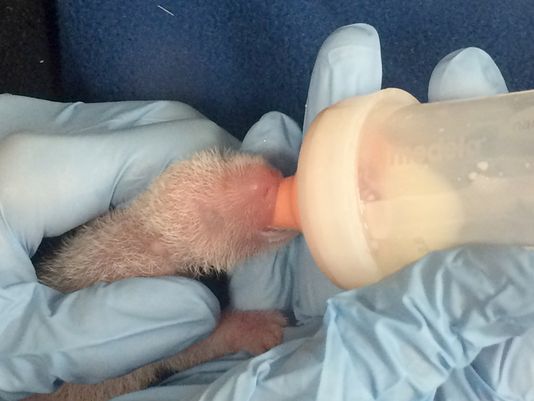
By Mark Young, SouthFloridaReporter.com Managing Editor, Aug 26, 2015 – It was only 4 days ago when the National Zoo proudly announced the birth of not one but two baby giant pandas. Today they sadly announced that one of the babies has died. Here’s the email with the sad news:
We are so sad to announce that the smaller of the two giant panda cubs born at the Smithsonian’s National Zoo Aug. 22, died shortly after 2 p.m. today, Aug. 26. The panda team rotated both cubs in the past 24 hours allowing each to benefit from spending time with their mother, Mei Xiang. The smaller cub was with Mei Xiang from about 2 p.m. yesterday, Aug. 25, until this morning. When the panda team swapped the cubs this morning, they assessed the little cub and had concerns because it had not increased in weight, appeared weaker and exhibited possible respiratory issues.
The panda team immediately began taking actions to improve the condition of the smaller cub. They administered antibiotics, respiratory support, formula and fluids.
The Zoo’s pathologists will perform a necropsy (animal autopsy) on the 4-day-old giant cub. A final pathology report will provide more information in the next few weeks. The veterinary and pathology team will continue to work closely during the ongoing histological evaluation.
At the time of death, the cub weighed 79.8 grams, about 2.8 ounces. The mortality rate for panda cubs in their first year in human care is 26 percent for males and 20 percent for females. Note that some early mortality rates may be underestimated.
Giant pandas give birth to twins approximately 50 percent of the time.
This is only the third time a giant panda living in the United States has given birth to twins. At the birth of the second cub, Mei Xiang demonstrated that she was challenged to care for both cubs, but she did not indicate a preference for one cub over the other. The collective scientific knowledge about giant panda mothers is that they are best able to care for one cub at a time.
Per the Giant Panda Twin Hand-Rearing protocol, the panda team alternately swapped the cubs, allowing one to nurse and spend time with Mei Xiang while the other was bottle fed and kept warm in an incubator. The primary goal for the panda team was for both cubs to have the benefit of nursing and spending time with their mother. The cub-swapping approach the panda team used to care for the twin cubs was developed by Chinese colleagues during the past 15 years.
The Zoo’s panda team is monitoring Mei Xiang and the cub via the Zoo’s panda cams. They are encouraged that this cub appears to be strong and robust, and that it is behaving normally, urinating and defecating. At last weigh-in, the cub weighed 137.7 grams. Despite these encouraging signs, the team continues to closely monitor both Mei Xiang and her cub around the clock, as the cub is still vulnerable and the risk remains high.
Due to a high volume of viewers, you may experience trouble playing the panda cams. Please try to refresh the page to reestablish your connection; or if you’d like to watch the cam uninterrupted, we suggest downloading the Smithsonian’s National Zoo App.
Don’t forget to follow @smithsonianzoo on Instagram for behind-the-scenes photos and videos with the hashtags #PandaStory and #InstaScience.












